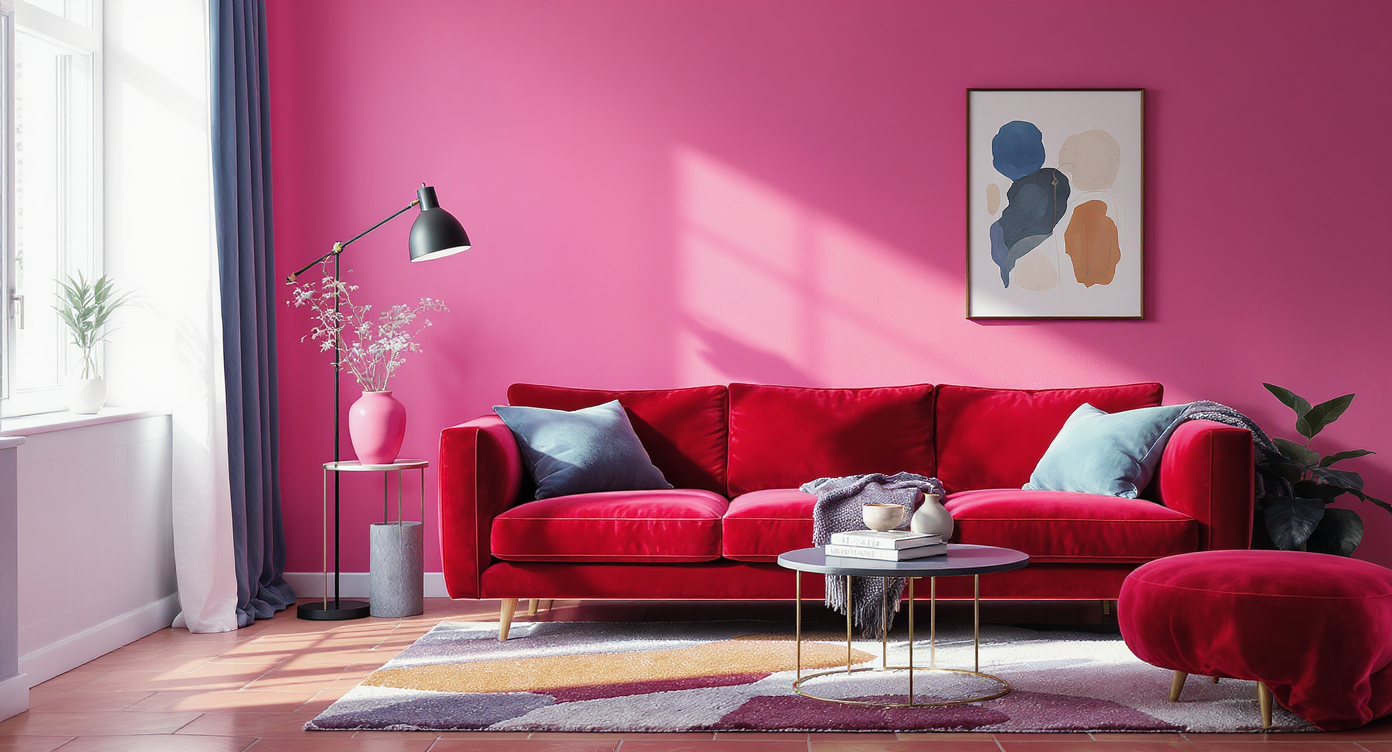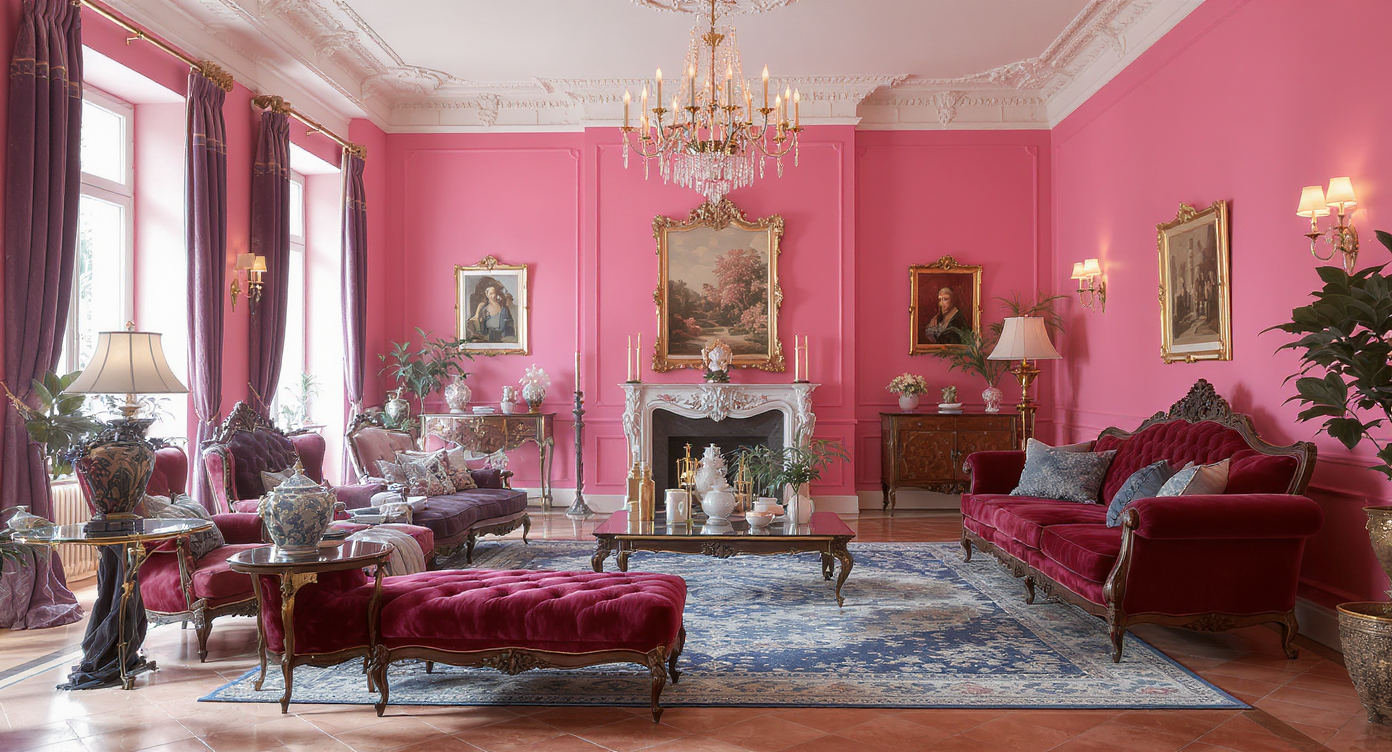TL;DR
Quick answer: don’t rush back to beige. To make pink walls look sophisticated, paint the ceiling white or a lighter tint, add cool contrast like navy and emerald, bring in large plants, and refine the lighting. This approach balances maximalist decor without sacrificing your personality and is the fastest way to tone down a brothel vibe while keeping what you love.
The pink-wall panic, explained

Layering contrast and lighting can transform pink rooms from overwhelming to intentionally dramatic and inviting.
Here’s the thing about pink walls: they can read luxurious, romantic, Miami-classic, or yes, a little bordello if the rest of the room leans too warm and too samey. That doesn’t mean you made a mistake. It just means the styling isn’t finished yet. Designers often note that a strong wall color needs contrast, breaks, and a few counterpoints to sing. If your space combines pink walls, a pink or red velvet sofa, warm terracotta tile, a red lamp, and a neon sign, your eye never gets a cool pause. What you’re reading as “brothel” is really a lack of contrast and layered lighting — both are easy fixes. This is your first place and those pieces have meaning. You don’t need to erase them with beige. You need to frame them better. The goal: keep the romance of pink walls while shifting the room toward refined maximalism.
Core strategy: keep the pink, adjust the balance
The fastest way to refine pink walls is to change the ceiling, lighting, and color contrast before you ever repaint a wall. - Paint the ceiling white or a 10–20 percent lighter tint of your wall color to visually lift the room. A light ceiling can make an 8-foot room feel 3–6 inches taller to the eye. - Follow a 60-30-10 color rule: 60 percent pink walls, 30 percent balancing neutrals or cool tones (ivory, navy, slate blue, deep green), 10 percent metallics like brass or gold. - Add a large rug to calm busy floors. On tile, an 8x10 works for most living rooms; aim to get the front legs of major furniture on the rug and leave an 8–12 inch floor border. - Swap the red lamp and any neon word signs for layered warm light: table lamps with off-white or pleated shades, a dimmer on the chandelier, and a glow at seating level. Use 2700–3000K bulbs for flattering light. - Break up the pink edge. Paint baseboards and crown molding semi-gloss white, or add 4–6 inch crown to frame the room and cut the color plane. - Introduce cool counterpoints. Navy velvet cushions, an emerald throw, a teal or cobalt accent vase, and lush greenery pull pink toward sophisticated rather than theme-y. User insight: many people find that painting only the ceiling white and adding two big plants — think a 5–6 foot monstera and a rubber tree — is enough to shift the vibe in a weekend.
Anecdote
Alt text suggestion: Pink living room with white ceiling, terracotta tile, vintage velvet sofa, brass mirror, and large monstera. Caption: How to balance pink walls with cool accents so the room feels stylish, not theme-y.
Common mistakes and how to avoid them
Most “brothel chic” happens by accident when everything is warm, shiny, and the same value of color. - Painting the ceiling the same bold color. It compresses the room. Keep the ceiling lighter to create air and height. - One-note lighting. Red bulbs, neon signs, or only overhead light create harsh drama. Layer at least three sources — overhead, table, accent — and dim them. - Matchy-matchy pinks. A pink wall plus pink sofa plus pink rug flattens the space. Add navy, emerald, or cream so the eye rests. - Tiny rugs on tile. Small rugs make furniture float. Size up so the seating zone is visually anchored. - No greenery. Pink loves green. Without plants, you miss the natural countercolor that keeps maximalist decor feeling fresh. Experts recommend editing just two items that shout the theme — often a neon sign or a red lampshade — and replacing them with timeless lighting to elevate the mood instantly.
Pro tips designers actually use
If you want a room that looks curated, not kitschy, treat finish and proportion like your north star. - Finish matters. For walls, choose a matte finish to avoid glare. Use semi-gloss for trim so details pop. - Crown molding is your friend. A 4–6 inch profile visually “caps” the color and makes even bold walls look architectural. - Color-tune your bulbs. 2700K bulbs are flattering for skin and fabrics; avoid stark 4000K in living spaces. - Mix eras smartly. Pair that vintage gilt mirror with one contemporary side table or a modern marble coffee table to sidestep costume-y vibes. - Plant scale by the numbers. One big plant per 6–8 feet of wall is a reliable rule of thumb; keep leaf tips 12 inches from the ceiling to avoid crowding. Designers often advise sampling three textiles in cool hues — one patterned, one solid, one textured — before buying anything. If they harmonize on a chair, they’ll sing in the room.
Anecdotes and real stories that prove it works
Real homes prove that small, targeted changes beat total repaints. - The white-ceiling win. A reader with a saturated pink living room kept her walls, rolled the ceiling white, and added an 8x10 ivory wool rug. The room felt a foot taller and finally showed off her vintage sofa instead of swallowing it. - The lighting swap. A client ditched a neon word sign and a red shade for two brass pharmacy lamps on dimmers. Same furniture, new mood — suddenly it read old-Hollywood lounge, not late-night lounge. - The plant pivot. In a Miami apartment with terracotta tile, a tall monstera and a rubber plant in brass planters cooled the palette. Emerald pillows and a navy throw tied the greenery to the seating. - The contrast correction. Someone once joked that a friend’s bold room was “cocaine chic.” She leaned into cooler tones instead — an aqua velvet cushion, a teal rug border, and a cream lampshade — and the comment never resurfaced. Takeaway: the look you want is probably two tweaks away. Start with the ceiling, lights, and a big rug, then season with blues, greens, and gold.
Visualization Scenario
Picture this: late afternoon light hits your pink walls, the ceiling glows softly white, a navy throw grounds the velvet chaise, and a brass lamp pools warm light onto a marble-topped table. Two big plants frame the mirror, their deep green leaves cooling the palette. The neon is gone, the chandelier is dimmed, and the tile is mostly covered by a plush ivory rug. It’s still romantic — now it’s unmistakably intentional.
FAQ
- Should I paint my pink living room beige? If you like the color, no — paint the ceiling white, add a large rug, and layer navy or emerald accents to balance the pink. Beige is optional, not required.
- How do I make pink walls look sophisticated? Use matte paint on walls, crisp white trim, brass details, and deep green plants; swap novelty neon for warm table lamps on dimmers.
- What colors go with pink walls and terracotta tile? Designers favor navy, cobalt, teal, olive, and cream; these cooler tones counter the warmth of both pink and tile for a balanced palette.
- How can I tone down a brothel vibe without repainting? Remove red bulbs and neon, paint the ceiling lighter, add one big plant, and introduce a blue or emerald textile — the mood shifts immediately.
- What size rug should I use on tile floors? In most living rooms, an 8x10 is minimum; keep the front legs of sofas and chairs on the rug and leave 8–12 inches of visible floor at the perimeter.
Own your palette, not anyone’s opinion
You chose pink on purpose. Let it be the star — just give it a stage partner. A lighter ceiling, better-scaled rugs, layered lighting, and a few cool accents will turn playful pink walls into a polished, maximalist living room you’ll be proud to show off. Beige isn’t the only way to feel grown up. It’s just the fastest way to erase your personality.
.svg)

.svg)
.jpg)













.png)